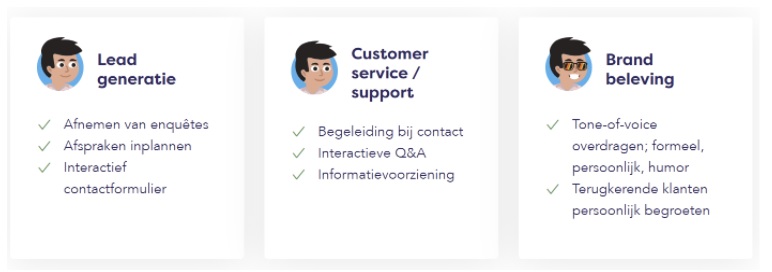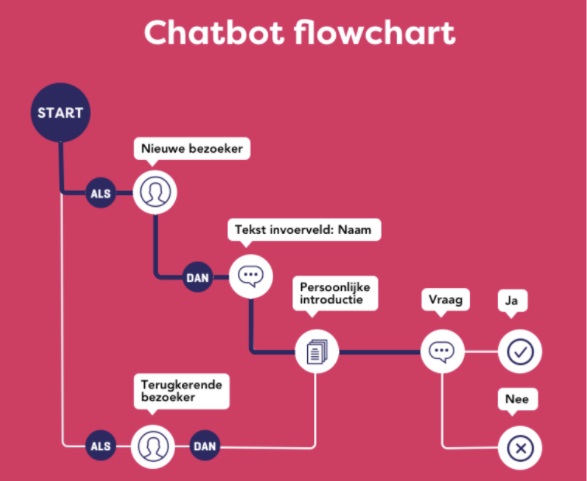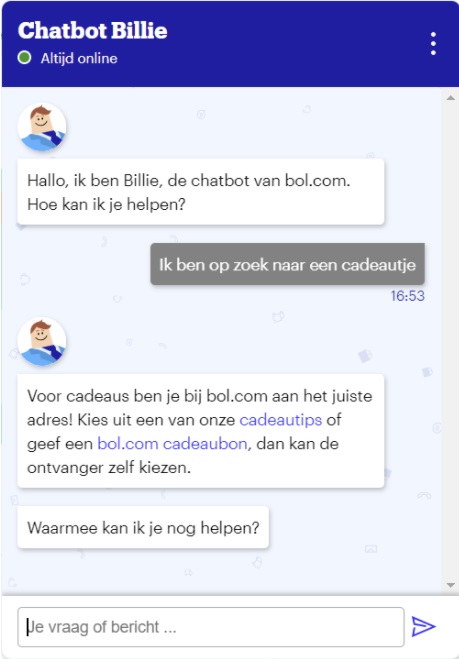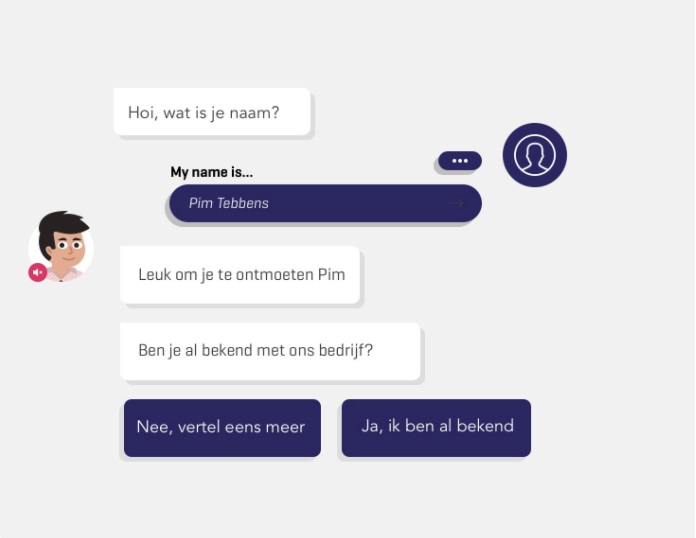- Marketing
Chatbots are becoming more and more popular. It is slowly becoming the most natural thing in the world to place orders via chatbots, book a taxi or schedule that appointment with the dentist that you look forward to. Millennials today even prefer a chatbot to an employee for answering short questions.
A good example of the success of chatbots is Billie, the chatbot from bol.com. On a daily basis, the chatbot receives almost half of all customer contact, of which it successfully completes 70% of the questions. During Black Friday (2018), this chatbot on its own accounted for the work of no less than 225 FTE on customer service. Those are numbers!
In this article we list the advantages and possibilities of a chatbot for you. Don’t feel like reading? Be sure to check out our own chatbot Buddy, he will be happy to interactively tell you everything about chatbots!

Benefits of a chatbot
A well-designed chatbot helps your customers quickly and easily with the right information, even if no employee is available. It is even possible to send a customer visit by having the chatbot return to multiple parts of the site and in this way guide the customer through the site.
If the customer cannot resolve the matter with the chatbot, he or she can forward him or her to someone from customer service or create a callback request.
A chatbot can therefore relieve customer service by solving questions that are still being handled by people. But a chatbot can also be of added value for more complex questions; For example, the time of a conversation with customer service can be shortened considerably by writing down someone’s details and question. Handy for you, but also for the customer! After all, nothing is more frustrating than being put through and then being able to tell the whole story again.
It is also possible to use a chatbot for taking surveys, planning an appointment or reservation, or giving useful tips for vacation. You see, for example, that in addition to the usual apps, airports now also use chatbots to share information about flight times or maximum baggage allowance.
But in addition to providing information, chatbots can also increase conversion. Stores can use chatbots to point customers to an assortment, such as a clothing store that allows customers to send a photo of a piece of clothing via a chatbot, where the chatbot then searches for a comparable assortment.
Chatbots give websites the ability to deliver a more personalised experience without scaling the human resources department.

How does it work?
But how does a chatbot actually work? Chatbots come in many different forms. Of course, the tone-of-voice and appearance differ per website, but the technology behind it can also differ considerably. We will walk you through two different technologies.
AI Chatbot: the chatbot with Artificial Intelligence
Some chatbots use Artificial Intelligence (AI) in combination with tools to understand language and possibly Machine Learning to constantly improve. In this way, the chatbot tries to create a similar experience as a conversation with an employee. By tapping into specific keywords such as “order”, the chatbot tries to understand what the customer’s search intention is. The chatbot then checks the database to see whether an answer sufficiently matches the (probable) question of the customer.
These chats often follow a freer path, as the customer constantly presents unique phrases that the chatbot responds to. If the customer notices that the bot has misunderstood him or her, it can quickly switch with another question. In this way, a bot tries to make the experience resemble a conversation with an employee as much as possible.
However, there are also disadvantages to this technology. By leaving the customer completely free in his or her input, you have less control over the experience and flow of the conversation. In addition, such chatbots must have a fair amount of dialogue and intelligence to justify free input. For example, if you only have a script available for the status of an order, the chatbot will say “Sorry, do you mean…?” on almost every other sentence. have to answer.
Another drawback is the oversight of language use. One customer uses the term “order”, the other “package” and another perhaps “order”. Although technology is making great strides, stiff conversations are sometimes unavoidable if the chatbot doesn’t understand the customer. Even though the customer knows that they are talking to a chatbot*, this breaks the immersion and also causes a lot of frustration, resulting in a customer dropping out.
*It is important to clarify whether a visitor is talking to a human or chatbot. A Mindshare survey has shown that 75% of visitors want to know who (or what) they are talking to.
“75% of visitors want to know who (or what) they are talking to”
Scripted Chatbot: Controlled Chat
An alternative is to give the customer a fixed number of options from which to choose. The customer navigates through the conversation by means of questions and sentences presented. This can be supplemented with input fields for values that cannot be determined in advance, such as a name or invoice number. The chatbot’s script remembers this data, and can return it if desired (“is that your phone number?”) or forward it to an employee at the end of the conversation.
Although this form of chatbots may feel a bit more limited at first, they are a lot more focused. In addition, numerous inhakers are still possible through the use of time blocks (“good morning, happy Tuesday”, etc.) and the reuse of input (“Welcome back Daan” ). By giving up some freedom, the customer can be sure that they will receive a logical answer to a proposed question, because your company has carefully thought about this specific flow. Or by us of course.. 😉
Scripted Chatbots are therefore extremely suitable for, for example, ordering food or giving gift suggestions via an interactive chat script. In that case, free chat would require a lot more chatting back and forth to achieve the desired result, and it is of course impossible to set up human employees here during the busy festive periods.

Chat Personas and Brand Experience
We already mentioned that it is possible to use a chatbot to guide a customer through the website. But a chatbot can also be an extension of your brand experience. Chatbots can be adjusted to your own tone-of-voice and can communicate both formally and informally. It is also possible to add humor to your chatbot, but be careful with this. Of course you don’t want an angry customer who tries to file a complaint to feel not taken seriously because you have continuously incorporated jokes into the script.
Some companies opt for a neutral chatbot without a clear persona, while bol.com, for example, uses the existing mascot Billie as chat persona. A persona is an additional way to consistently communicate with your target audience. By giving the chatbot a personality, it is easier to keep the same tone-of-voice.
If you use a persona, it is important that it communicates with the customer in a way that your employees would also do. In this way, the chatbot feels like an extension of your company, instead of a separate identity.
"73% of respondents do not want to use a company chatbot again if they have had a negative experience with it before"
Facts about Chatbots
We see a promising future for chatbots. But we are not alone! Many studies have already been done on the use of chatbots, and we would like to list a few for you:
- 38% of customers are positive about a chatbot, compared to 11% negative. The other 51% have a neutral opinion about chatbots. This was revealed in a survey conducted by LivePerson among 5.000 customers in six different countries.
- 40% of respondents from a HubSpot survey don’t care if a human or chatbot helps them.
- 56% of respondents (worldwide) prefer to talk to a human, according to a study by Business Insider.
- 73% of respondents would not want to use a company chatbot again if they have had a negative experience with it before. This was revealed in a survey by DigitasLBi within the American market.
ChatBuddy
So, at Get Interactive we are very enthusiastic about the possibilities of chatbots. So excited that we are proud to share our special website with you where we put our chatbot “Buddy” in the spotlight. So if you want to see an example of a chatbot in action, be sure to take a look!

Do you want to use a chatbot for your company?
We hope this article has inspired you to think about adding a chatbot to your website. Have you become enthusiastic about the possibilities? Then we would like to see what we can do for you.


